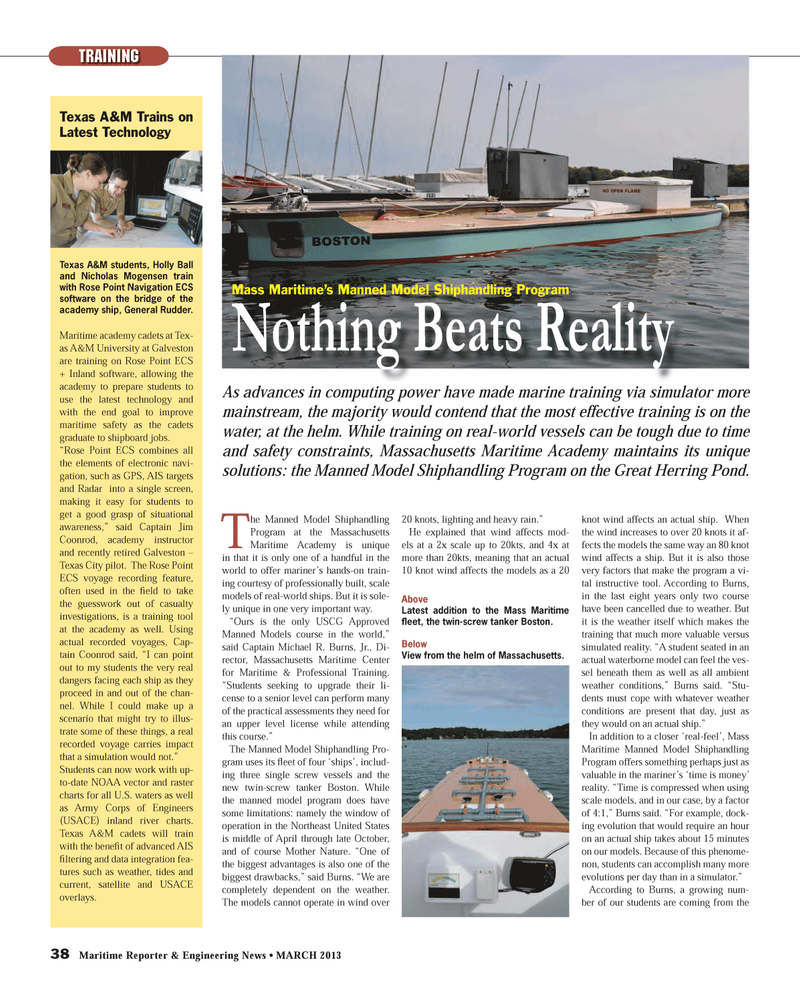
Page 38: of Maritime Reporter Magazine (March 2013)
U.S. Coast Guard Annual
Read this page in Pdf, Flash or Html5 edition of March 2013 Maritime Reporter Magazine
38 Maritime Reporter & Engineering News ? MARCH 2013 The Manned Model Shiphandling Program at the Massachusetts Maritime Academy is unique in that it is only one of a handful in the world to offer mariner?s hands-on train- ing courtesy of professionally built, scale models of real-world ships. But it is sole-ly unique in one very important way. ?Ours is the only USCG Approved Manned Models course in the world,? said Captain Michael R. Burns, Jr., Di- rector, Massachusetts Maritime Center for Maritime & Professional Training. ?Students seeking to upgrade their li-cense to a senior level can perform many of the practical assessments they need for an upper level license while attending this course.?The Manned Model Shiphandling Pro-gram uses its ß eet of four ?ships?, includ- ing three single screw vessels and the new twin-screw tanker Boston. While the manned model program does have some limitations: namely the window of operation in the Northeast United States is middle of April through late October, and of course Mother Nature. ?One of the biggest advantages is also one of the biggest drawbacks,? said Burns. ?We are completely dependent on the weather. The models cannot operate in wind over 20 knots, lighting and heavy rain.?He explained that wind affects mod- els at a 2x scale up to 20kts, and 4x at more than 20kts, meaning that an actual 10 knot wind affects the models as a 20 knot wind affects an actual ship. When the wind increases to over 20 knots it af-fects the models the same way an 80 knot wind affects a ship. But it is also those very factors that make the program a vi-tal instructive tool. According to Burns, in the last eight years only two course have been cancelled due to weather. But it is the weather itself which makes the training that much more valuable versus simulated reality. ?A student seated in an actual waterborne model can feel the ves-sel beneath them as well as all ambient weather conditions,? Burns said. ?Stu-dents must cope with whatever weather conditions are present that day, just as they would on an actual ship.?In addition to a closer ?real-feel?, Mass Maritime Manned Model Shiphandling Program offers something perhaps just as valuable in the mariner?s ?time is money? reality. ?Time is compressed when using scale models, and in our case, by a factor of 4:1,? Burns said. ?For example, dock-ing evolution that would require an hour on an actual ship takes about 15 minutes on our models. Because of this phenome-non, students can accomplish many more evolutions per day than in a simulator.? According to Burns, a growing num-ber of our students are coming from the TRAININGTexas A&M Trains on Latest Technology Texas A&M students, Holly Ball and Nicholas Mogensen train with Rose Point Navigation ECS software on the bridge of the academy ship, General Rudder. Maritime academy cadets at Tex- as A&M University at Galveston are training on Rose Point ECS + Inland software, allowing the academy to prepare students to use the latest technology and with the end goal to improve maritime safety as the cadets graduate to shipboard jobs. ?Rose Point ECS combines all the elements of electronic navi-gation, such as GPS, AIS targets and Radar into a single screen, making it easy for students to get a good grasp of situational awareness,? said Captain Jim Coonrod, academy instructor and recently retired Galveston ? Texas City pilot. The Rose Point ECS voyage recording feature, often used in the Þ eld to take the guesswork out of casualty investigations, is a training tool at the academy as well. Using actual recorded voyages, Cap-tain Coonrod said, ?I can point out to my students the very real dangers facing each ship as they proceed in and out of the chan-nel. While I could make up a scenario that might try to illus-trate some of these things, a real recorded voyage carries impact that a simulation would not.?Students can now work with up-to-date NOAA vector and raster charts for all U.S. waters as well as Army Corps of Engineers (USACE) inland river charts. Texas A&M cadets will train with the beneÞ t of advanced AIS Þ ltering and data integration fea- tures such as weather, tides and current, satellite and USACE overlays. Mass Maritime?s Manned Model Shiphandling Program Nothing Beats Reality As advances in computing power have made marine training via simulator more mainstream, the majority would contend that the most effective training is on the water, at the helm. While training on real-world vessels can be tough due to time and safety constraints, Massachusetts Maritime Academy maintains its unique solutions: the Manned Model Shiphandling Program on the Great Herring Pond. Above Latest addition to the Mass Maritime ß eet, the twin-screw tanker Boston. BelowView from the helm of Massachusetts. MR #3 (34-41).indd 38MR #3 (34-41).indd 383/1/2013 9:59:00 AM3/1/2013 9:59:00 AM

 37
37

 39
39
